Multi-Channel Attribution for Marketing: Top 5 Tools to Get You Started
A lot of things happen before a B2B business finalizes a purchase decision. They would usually have a long purchase cycle that lasts several weeks and comprises of engagement from several channels and decision markers. There is a buildup of events, interactions, and experiences that eventually culminate into a purchase.
With this much complexity at hand, things can get really messy. Imagine having the ability to understand, monitor and optimize these events, interactions, and experiences when it comes to your customers. Must be a daunting task!
It is hard but it is doable through Multi-channel marketing attribution. We shall cover all its basics and also suggest some powerful tools for you to hit the ground running with multi-channel marketing attribution.
What is Marketing Attribution?
Marketing attribution is an analytics and reporting approach that helps B2B businesses understand how their marketing efforts impact customer behavior and drive desired outcomes.
It involves analyzing the various touchpoints or interactions a customer has with a brand through different channels before taking a specific action. These interactions can be done through website, live chat, demos, social media, emails, etc.
The goal of marketing attribution is to understand which channels and touchpoints are most effective in driving the desired outcome. It allows decision-makers to make data-driven decisions to optimize the allocation of marketing resources.
Thus, with marketing attribution, they will be able to move more leads through the sales funnel efficiently!
Next, we will understand the B2B Customer Journey and the role of multiple channels in it.
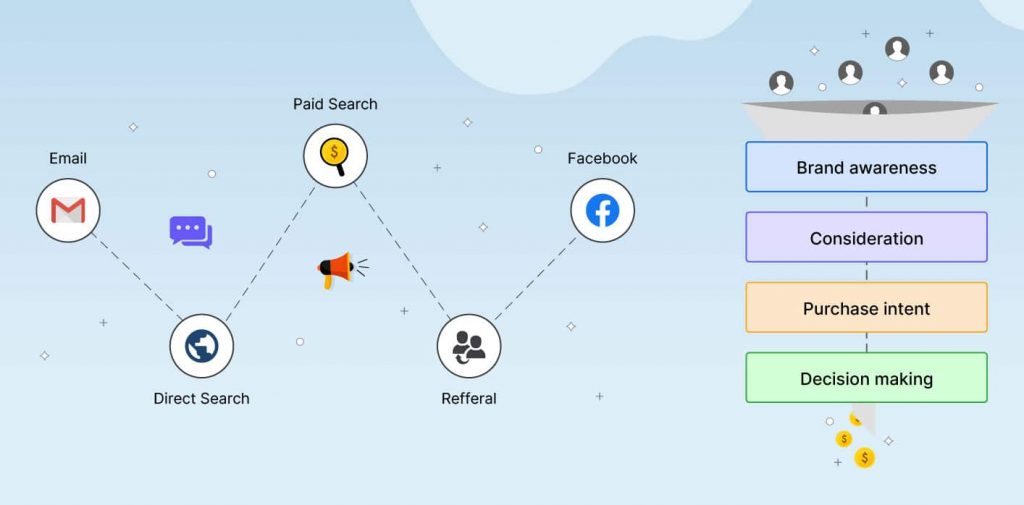
Understanding the Customer Journey and The Role of Multiple Channels
Purchase decisions don’t happen in an instant and have a strong buildup of events leading to the final decision. Thus, it becomes important to understand this buildup of events via the Customer Journey.
For B2B, the standard stages of awareness, consideration, evaluation, and purchase are still present. However, these are spread across multiple channels.
Let’s consider an example. A potential client who was looking for a service you provide ended up on your website after a Google search. He looks around, checks pricing, and then leaves.
Sometime after he stumbles upon a social media post by your firm and interacts with it. He may then find himself googling for a requirement-related query and ends up on a blog post published by you. You’ve created a positive impression by now.
Subsequently, they subscribe to your newsletter and regularly read your blogs. By now they’re convinced about your expertise in the subject matter. Next, they might come across a PPC ad positioned to present you as an alternative to your competition. They check out the landing page and understand how you’re the better option. Around a similar time, they receive an email about a promotional offer that gives them a 20% discount. Maybe this was the last piece and they are now finalizing the purchase.
Now, if you observe carefully, you will notice a buildup across multiple channels that led to the final purchase decision. Thus, with multi-channel attribution, you will uncover a lot of actionable insights and be in a position to positively impact the buildup to purchase.
Key Challenges in Attribution Across Multiple Channels
It should go without saying that the complexities of multi-channel marketing attribution present a key set of challenges. Let’s take a closer look at some of these challenges:
Data Fragmentation: Customer interactions can happen across multiple channels, including email, social media, and paid advertising.
Improper or insufficient data management and synchronization can lead to data fragmentation. This can lead to data silos that make it challenging to connect the dots between each touchpoint.
Picking Attribution Models: There are multiple attribution models available, each with its strengths and weaknesses. Firstly, choosing the right model for your business can be quite challenging. Secondly, implementing it correctly requires a deep understanding of your customer journey and the impact of each touchpoint.
Cross-device Tracking: Users love to hop between devices while working. They may interact with your website from their desktop while interacting with a marketing campaign on their phone.
This makes cross-device tracking difficult. Moreover, firms such as Apple have disabled cross-app tracking and implemented stricter tracking controls. This has further added to the cross-device tracking challenge.
Time Lag: In B2B marketing, the time lag between initial engagement and a final purchase decision can be significant. This can make it challenging to attribute credit to each touchpoint accurately.
Multi-channel Attribution Strategy and Implementation
Let’s glance over what you need to do to get your multi-channel attribution correctly implemented.
Data Collection and Tracking
Start by setting up tracking. You need to formulate a strategy that allows you to track potential customers and their interactions in real time across multiple channels, platforms, and devices.
The next thing to plan for is to have all the data about customer interactions in one place. Proceed with validating and enhancing the said data to ensure your attribution is accurate.
Analytics and Reporting Tools
You need powerful analytics and reporting tools to implement an effective multi-channel attribution strategy.
With the right tools in place, businesses can accurately attribute credit to each touchpoint. This further enables them to make data-driven decisions, and continuously improve their marketing efforts.
Another benefit of using the right analytics tools is the ability to measure and maximize ROI from different marketing campaigns.
Data Integration and Analysis
Make a note of this. Effective multi-channel marketing attribution requires both the big picture and the tiny details. Properly planned data integrations will allow you to funnel data from different channels and touchpoints into one place.
With this, businesses can attain a comprehensive understanding of the customer journey, and identify the most effective touchpoints and improvement opportunities.
Analyzing the collected data can uncover many actionable insights. Businesses can identify patterns and trends in customer behavior, optimize budget allocation, and make data-driven decisions.
Next, we will check out the different attribution models.
Attribution models
Let’s take a look at the different multi-channel attribution models and understand how they work.
First Click Attribution
The first-click marketing attribution model assigns all credit for a conversion to the first touchpoint that a customer interacts with in their journey.

This model assumes that the first touchpoint is the most important in the customer’s decision-making process and gives it full credit for the conversion.
Last Click Attribution
The last-click marketing attribution model assigns all credit for a conversion to the last touchpoint that a customer interacts with before taking a desired action.

This model assumes that the last touchpoint is the most influential in the customer’s decision-making process and gives it full credit for the conversion.
Linear Attribution
The linear marketing attribution model assigns equal credit to each touchpoint a customer interacts with on their journey to taking a desired action.

This model assumes that each touchpoint plays an equal role in the customer’s decision-making process and gives them all credit for the conversion.
Time Decay Attribution
The time decay marketing attribution model gives more credit to the touchpoints that are closer in time to the actual purchase or conversion.

This model assumes that the touchpoints that a customer interacts with more recently have more influence on their decision-making process.
Position Based Attribution
The position-based marketing attribution model gives the most credit to the first and last touchpoints a customer interacts with and distributes the remaining credit equally among the touchpoints in between.

This model assumes that the first touchpoint is responsible for creating initial brand awareness and the last touchpoint is responsible for the final conversion. While the touchpoints in between play a supporting role.
5 Multi-channel Attribution Tools
Let’s help you out on your journey with multi-channel marketing attribution. Here’s a list of the top 5 tools you can get started with!
1. Salespanel
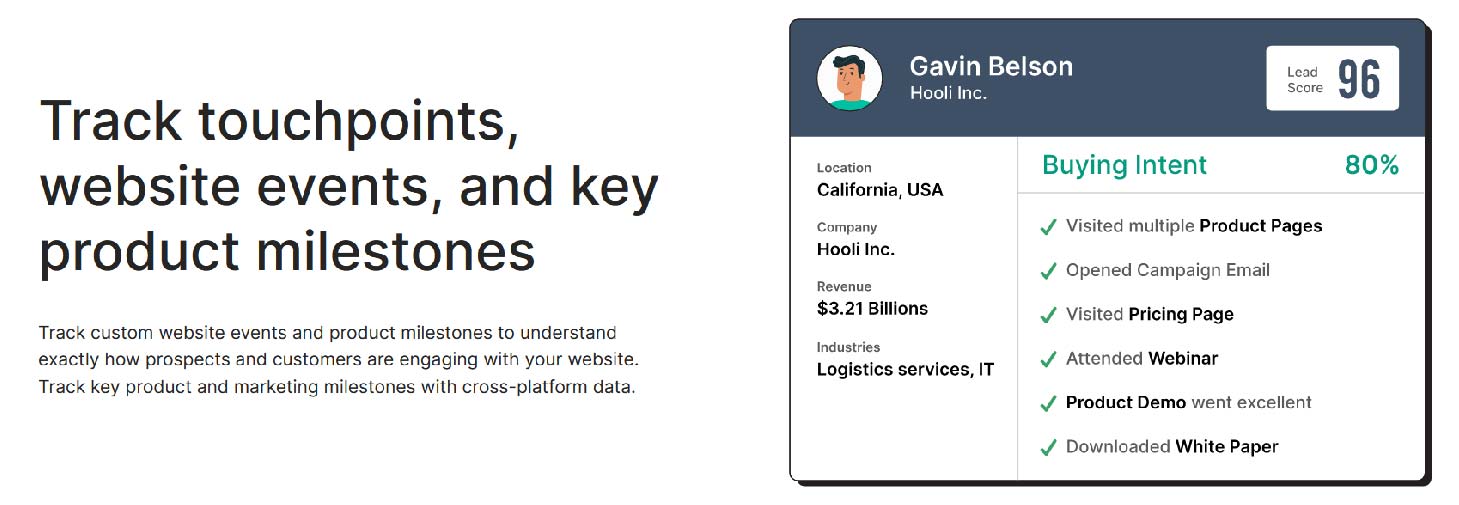
Salespanel has been designed while keeping multi-channel customer journey tracking and attribution in mind. The tool tracks the engagement of your customers from your website, application, and email campaigns and aggregates them in a single customer view. You can then analyze data, generate reports, segment and score leads, and send qualified prospects to your CRM.
Pros:
- The platform offers a comprehensive suite of features, including lead tracking, website visitor tracking, and campaign management, making it easy for businesses to track the customer journey from start to finish.
- Salespanel’s user-friendly interface and easy-to-use tools make it an ideal choice for businesses of all sizes, whether you’re a small startup or a large enterprise. The tool is designed primarily for B2B businesses.
- The platform provides real-time insights into user behavior, allowing businesses to respond quickly to customer needs and preferences.
- The platform’s competitive pricing makes it an affordable option for businesses looking to optimize their marketing efforts.
Cons:
- While the tool can be used by B2C businesses, it is not optimal for them because of how the product is priced.
- The platform is for customer journey tracking and marketing operations enablement. It is not an attribution modeling focused product.
Pricing
Salespanel offers a range of paid plans to suit the needs of businesses of varying sizes. Our paid plans start at $149 per month and you can also take a 14-day trial!
2. Hubspot Dashboard & Reporting
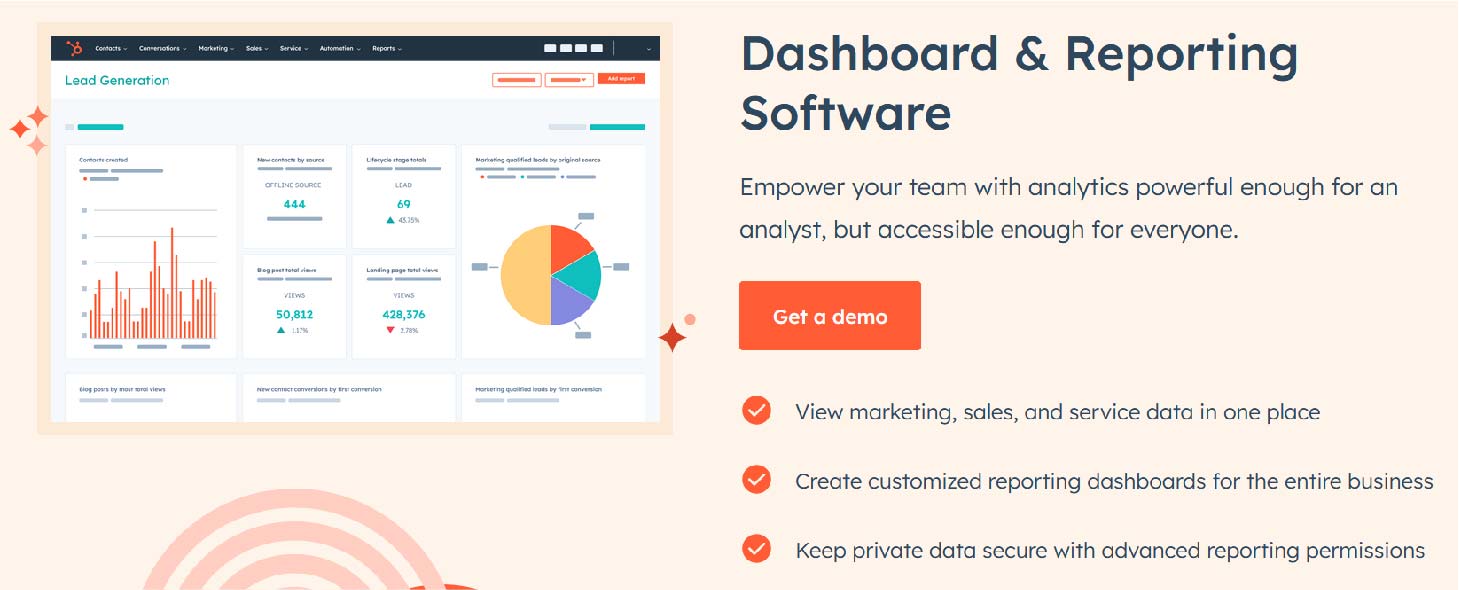
HubSpot’s dashboard and reporting tools provide some multi-channel attribution capabilities. Here is a review of its strengths and weaknesses:
Pros:
- HubSpot’s dashboard is user-friendly and customizable, allowing users to choose which metrics to display and how to visualize them.
- The platform offers a variety of reporting options, including custom reports and pre-built templates, which can be exported in various formats.
- HubSpot can integrate with Google Analytics, providing additional attribution insights beyond what is available within the platform.
Cons:
- This feature is only available on premium plans costing over $890 per month and might be beyond the budgets of smaller businesses.
Pricing:
HubSpot offers a range of pricing plans, with reporting and dashboard features included in most plans. Prices start at $890 per month for the Marketing Hub plan.
3. Adobe Analytics
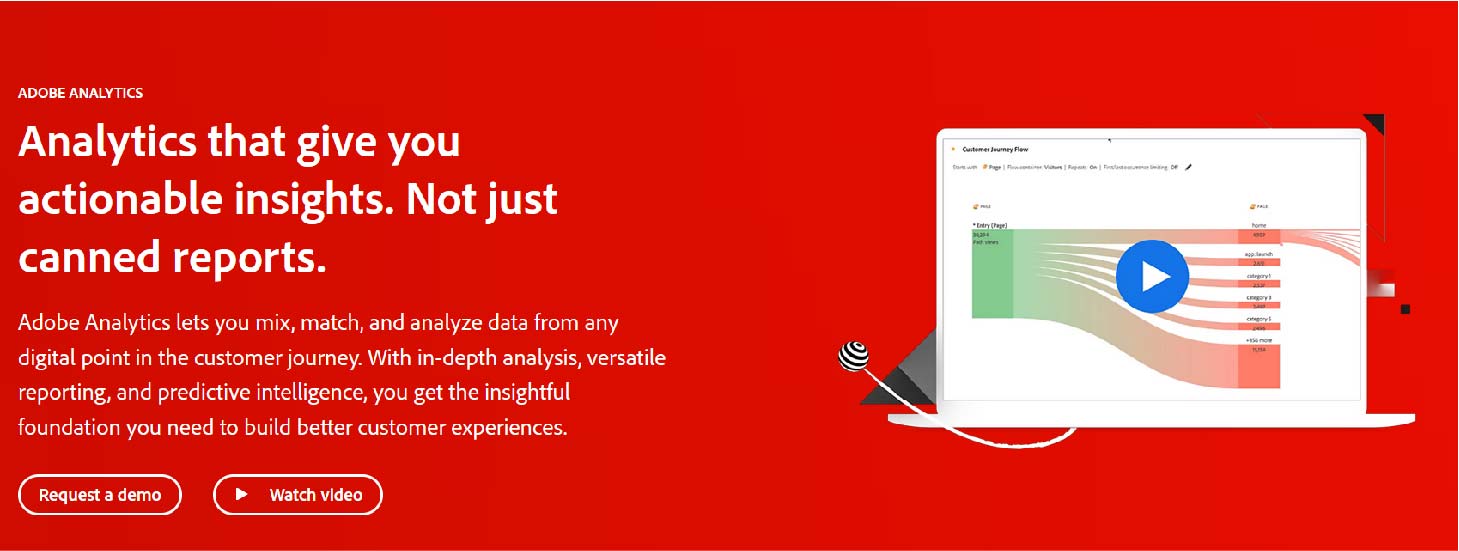
Adobe Analytics is a powerful tool for multi-channel marketing attribution that offers a range of useful features. One of its key strengths is its ability to track user behavior across multiple channels using Javascript tags and AppMeasurement libraries.
Pros:
- Comprehensive tracking across multiple channels, including email, social media, and mobile apps.
Advanced attribution modeling, allows businesses to assign credit to the channels and campaigns that are most effective. - Real-time analytics enable businesses to respond quickly to changes in customer behavior.
Cons:
- The steep learning curve for those new to the platform.
- Pricing can be expensive for smaller businesses or those with limited budgets.
- Advanced features may require additional customization or professional services.
Pricing:
Adobe Analytics offers a range of pricing plans depending on the specific needs of the business. The pricing is not publicly listed on the website and businesses must contact Adobe directly for a quote.
4. Mixpanel
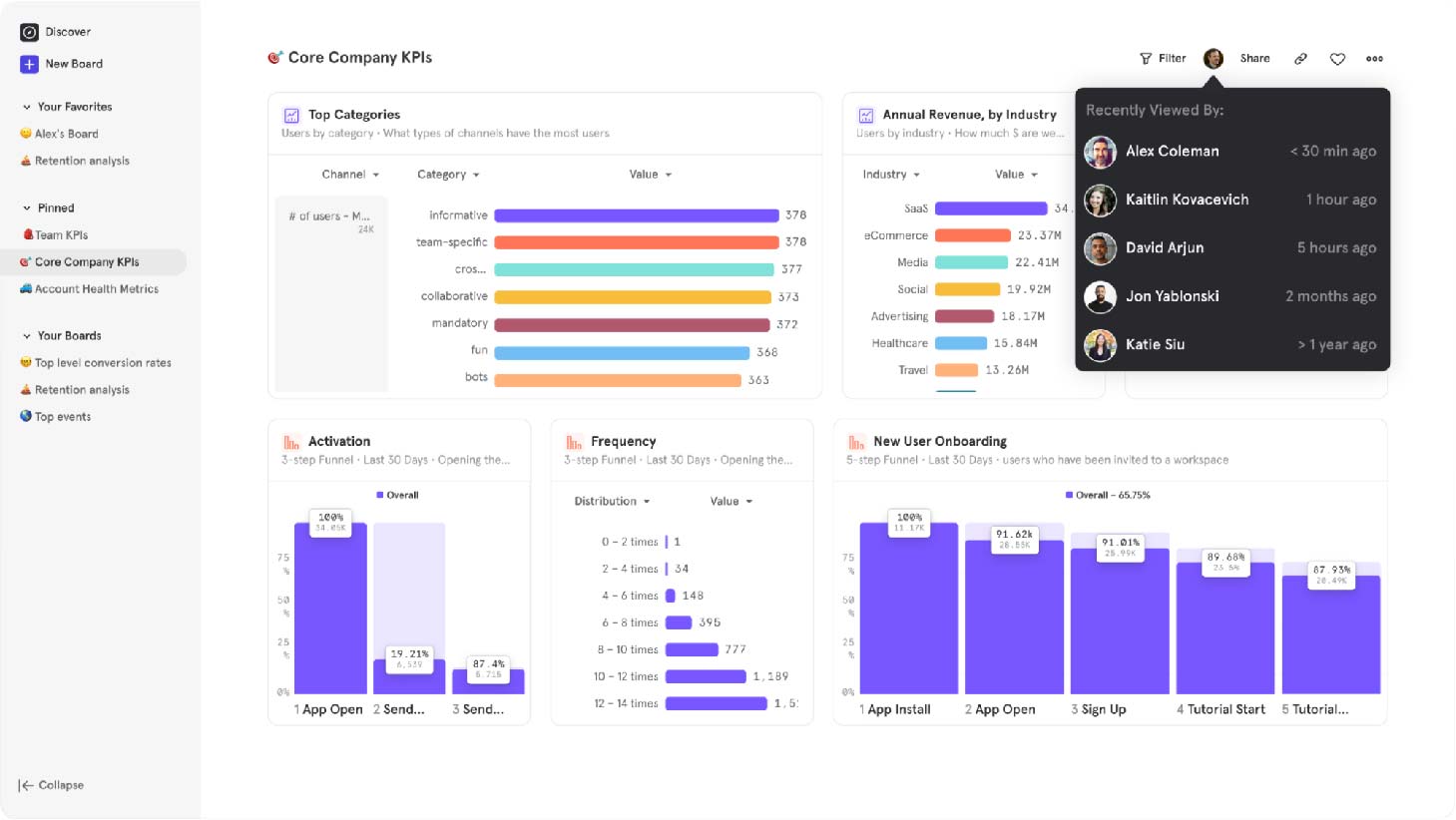
Mixpanel is a comprehensive analytics platform offering robust multi-channel marketing attribution functionalities at a competitive cost. It allows users to gain deep insights into the impact of diverse marketing channels on conversion rates. Its affordability and effectiveness make it an ideal solution for small businesses keen to leverage the power of multi-channel marketing attribution.
Pros:
- It offers a customizable and user-friendly interface, making it easy to navigate and analyze data.
- The tool provides robust cohort analysis, funnel analysis, and event-tracking features that help identify the best-performing channels and campaigns.
- It also offers real time data analysis and reporting, enabling users to monitor their marketing efforts in real time.
Cons:
- Mixpanel’s pricing model is based on data points, which can be limiting for larger businesses.
- The attribution capabilities are not as advanced as some of its competitors, with limited options for attribution models and channel reporting.
Pricing:
Mixpanel offers a free plan for up to 20 million events a month and paid plans start at $20 a month and offer 100 million events.
5. Ruleranalytics
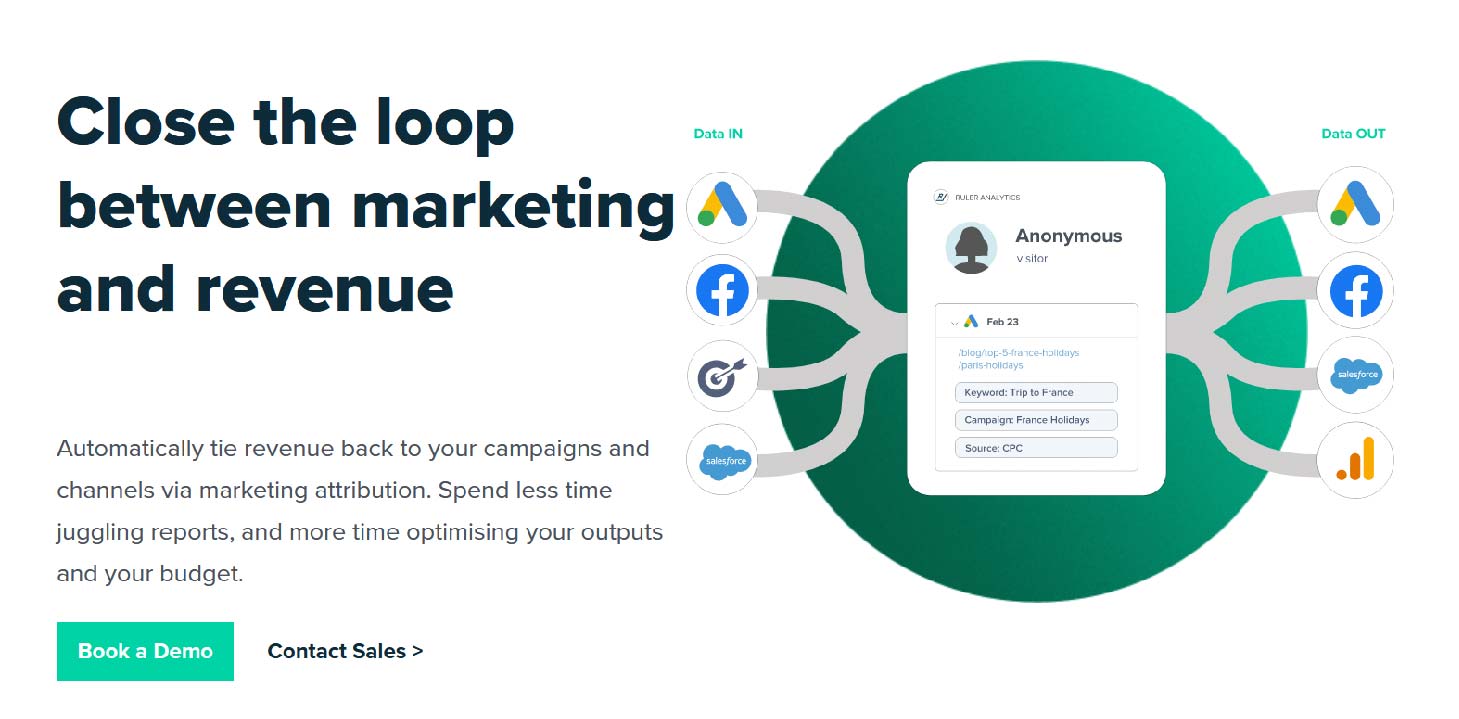
Ruler Analytics is a powerful multi-channel marketing attribution tool designed to help businesses identify which channels and campaigns are driving the most conversions.
Pros:
- User-friendly interface that is easy to navigate
- Advanced tracking capabilities that allow you to see the customer journey across multiple channels and devices
- Provides detailed reports and visualizations to help you understand the impact of your marketing campaigns
Cons:
- Some features, such as advanced reporting and integration with certain platforms, are only available on higher pricing plans
- The attribution model is fixed and cannot be customized.
- Limited customization options for dashboards and reports.
Pricing:
Ruler Analytics offers a range of pricing plans, starting at £199/month for the Basic plan and going up to £999/month for the Premium plan.
With that, we’re almost at the end of this blog. Let’s wrap this up!
Conclusion
Multi-channel marketing attribution allows you to have granular control over your marketing operations. With it, you’re able to monitor the performance of each channel and touchpoint.
These insights will enable you to make more informed decisions and improve marketing performance and ROI. We’ve covered almost everything you need to get started with multi-channel marketing attribution in this blog.
Sell more, understand your customers’ journey for free!
Sales and Marketing teams spend millions of dollars to bring visitors to your website. But do you track your customer’s journey? Do you know who buys and why?
Around 8% of your website traffic will sign up on your lead forms. What happens to the other 92% of your traffic? Can you identify your visiting accounts? Can you engage and retarget your qualified visitors even if they are not identified?



